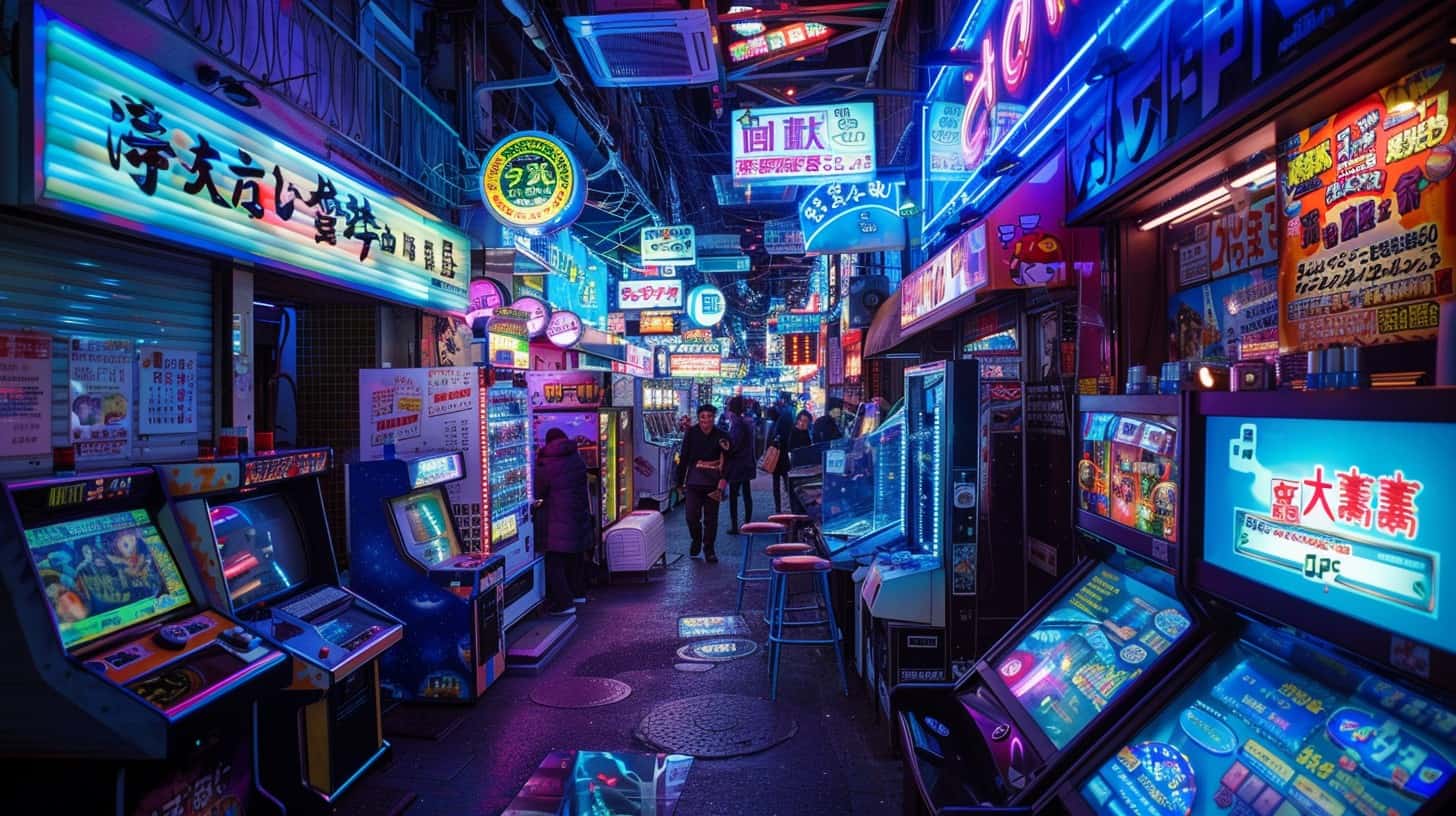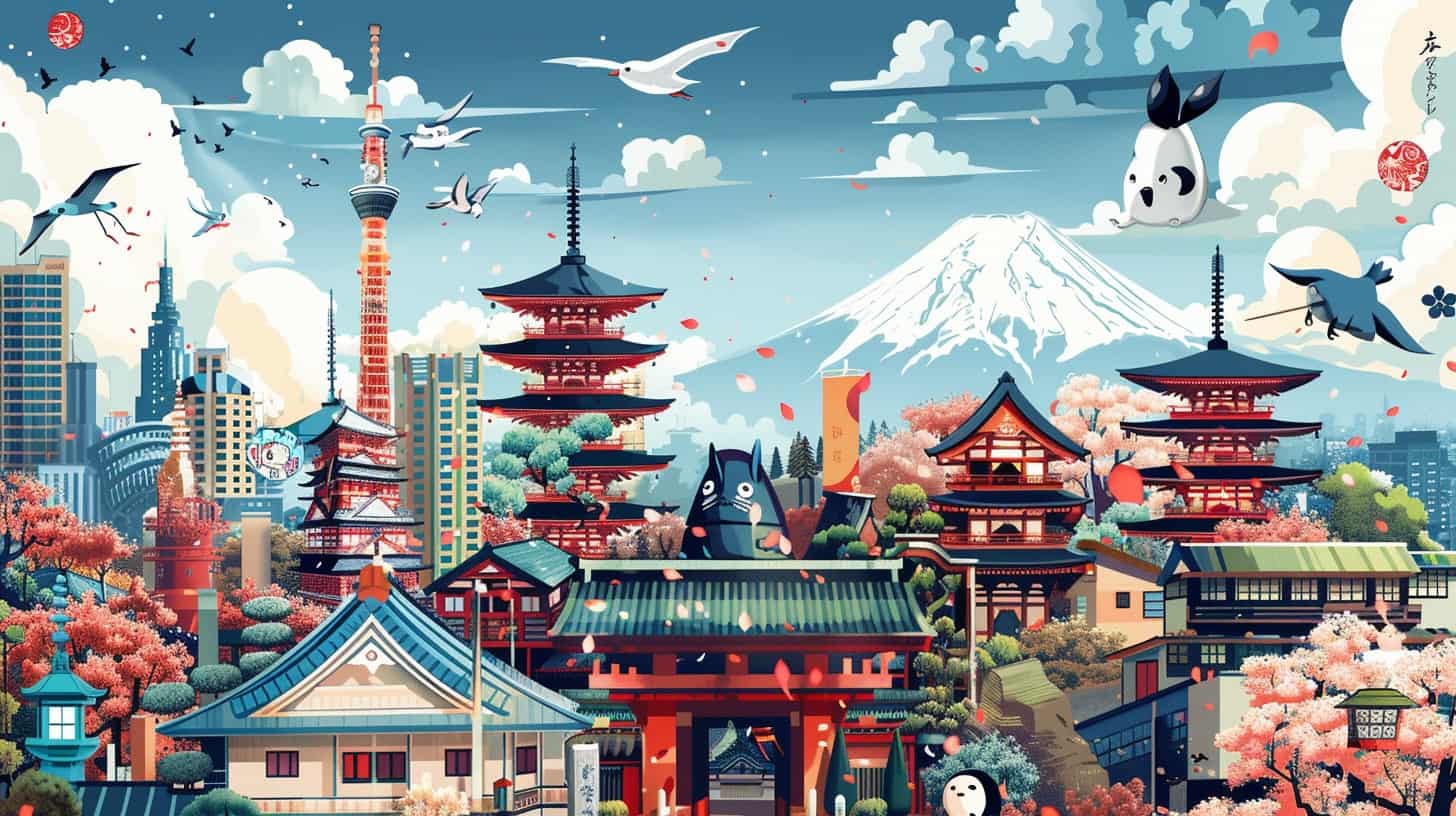Ever wonder why Japanese culture grabs global attention? It’s filled with an array of traditional arts, pop culture, and culinary delights that stand out on the world stage. This article will unlock nine compelling reasons behind its widespread appeal, guiding you through the intricate blend of ancient traditions and modern innovations.
Get ready to explore a cultural journey like no other.
Key Takeaways
Japanese arts like woodblock prints and samurai swords tell stories from Japan’s history, making them unique.
Anime, manga, and video games reach fans worldwide with their original stories and characters.
Japanese food is known for its balance of flavor and presentation, drawing people into its rich culinary tradition.
Video games mix old Japanese traditions with modern play, introducing players to the country’s culture.
E-sports in Japan blend gaming with cultural practices, attracting global gamers.
Table of Contents
Distinctive Elements of Japanese Culture

Japanese culture stands out with its blend of old arts and modern pop vibes. It captures hearts through unique traditions and worldwide loved comics and cartoons.
Mastery of Traditional Arts and Crafts
Woodblock prints, calligraphy, and painting stand as pillars of traditional Japanese arts. Craftsmen dedicate years to master these skills. Their work shows scenes from nature, history, and folklore that captivate anyone who sees them.
These pieces are not just art; they tell stories of Japan’s past.
Samurai swords and antique porcelain dishes also play a huge role in traditional crafts. Skilled artists make swords with techniques passed down through centuries. Each blade reflects the spirit of the samurai era.
Porcelain dishes, with their intricate designs, often find places in homes around the world as prized possessions or gifts.
Influence of Japanese Pop Culture
Moving from the traditional arts, Japanese pop culture really takes the spotlight with its dynamic range. Anime, manga, and video games are big deals all around the world. Shows like “Morning Musume” and bands such as X Japan play a huge role in spreading this culture globally.
American kids love Pokémon characters like Pikachu too. This shows how deep Japanese entertainment has dug its roots into global soil.
Japanese pop culture doesn’t stop there; it also includes mouth-watering cuisine that has reached every corner of the planet. Sushi restaurants can be found in almost any major city worldwide, proving that food is an essential part of this cultural wave.
Plus, mass media and clever marketing have made Japanese animation and culinary delights very profitable in places like the US.
Anime, manga, and video games aren’t just hobbies; they’re gateways to understanding a rich and vibrant culture.
Worldwide Influence of Japanese Culture

Japanese culture grabs hearts and minds around the globe. From cool animations to yummy food, its impact is huge, making us all fans in one way or another.
Global Fascination with Anime and Manga
Anime and manga attract fans worldwide because they offer stories unlike American superhero tales. These Japanese comics and animation pull from original manga or light novels, giving life to a vast universe of characters.
This difference is why many outside Japan love them.
Creators often focus on teenage heroes in light novels, connecting deeply with young audiences globally. Manga has made more people in America follow Japanese animation, showing its significant cultural impact.
Now, folks everywhere enjoy these captivating stories that anime and manga bring into their lives.
Japanese Cuisine: A Culinary Exploration
Moving from the vivid worlds of anime and manga, Japanese cuisine offers an equally compelling journey. This food culture is known for sushi, tempura, ramen, and beef sukiyaki. These dishes do more than fill the stomach; they tell stories of tradition, innovation, and artful presentation.
With ingredients that balance freshness with flavor, eating becomes an experience. It’s not just about tasting; it’s about appreciating every aspect of the meal.
Sake, beer, and whiskey are key drinks in this culinary adventure. They complement meals perfectly but also stand strong on their own. For instance, enjoying sake while exploring ancient castles in Osaka adds a new layer to the travel experience.
Each sip offers a deeper understanding of Japanese tradition and craftsmanship—proving that food and drink in Japan are much more than sustenance; they’re a form of connection to history and culture.
The Role of Gaming and Gambling in Popularizing Japanese Culture

Video games from Japan have taken the world by storm. They mix cool stories with exciting play, making gaming a big part of why people love Japanese culture.
The Pioneering Influence of Japanese Video Games
Japanese video games have reshaped global pop culture, luring players into vibrant worlds inspired by otaku and weeb interests. These digital adventures introduce audiences to esoteric elements of Japanese tradition, from samurais wielding katanas to mystical areas echoing the Edo period.
Icons like Super Mario and Final Fantasy entertain and educate on the subtleties of Japanese storytelling and aesthetics.
Integrating seamlessly with American leisure habits, these games foster a unique blend that includes competitive gaming, known as esports. Players worldwide don traditional garb for game launches or cosplay events, drawing direct lines to Harajuku fashion or anime series tropes.
This fusion has positioned Japan as an irreplaceable pillar in the entertainment sector, making kimono patterns and kanji characters familiar sights in video game landscapes far beyond Tokyo’s bustling streets.
The Cultural Impact of Japanese Game Design
After discovering how Japanese video games first made their mark, it’s clear that the impact of these game designs goes deep. Games from Japan have reshaped entertainment across the globe.
Iconic characters and immersive stories have set a new standard in gaming, with titles like “Final Fantasy” and “Pokémon.” These franchises aren’t just games; they’re part of global pop culture.
The design behind these games mixes traditional Japanese culture with cutting-edge technology. For example, elements from Shinto and Buddhist temples often appear in game landscapes, offering players a taste of Japan’s rich history.
Meanwhile, esports teams compete in tournaments that draw millions of viewers worldwide, showing off skills in games born from Japanese creativity. This blend of old and new has made Japanese game design a major force in shaping modern gaming tastes around the world.
Japan’s Influence in the Gambling Sector
Japan has a big role in the gambling sector, especially with games like pachinko and mahjong. These games are not just played for fun; they’re a huge part of Japanese culture. People worldwide enjoy these traditional Japanese games in casinos, thanks to Japan’s influence.
This shows how Japan shares its culture through gambling.
The country also thinks luck and chance are very important. This belief helps make gambling popular in Japan and other places too. Anime and manga bring this idea into video games and online slots, making it more exciting for fans around the world.
For example, you can play online slots at BETMGM that have themes from popular Japanese stories or characters.
Japanese pop culture extends its reach into the gaming world, blending traditional themes with modern gameplay to create a unique form of entertainment.
This blend of old tradition with new technology keeps Japan at the center of global gaming trends. It leads us to explore how gaming joins hands with traditional culture next.
The Fusion of Gaming and Traditional Culture
Video games from Japan mix old traditions with modern play. They show stories of samurai, ninja, and historical events in new ways. Players get to learn about Japanese tea ceremonies and martial arts while playing.
This makes gaming a unique way to experience Japanese culture.
E-sports take this blend further. Competitions feature games inspired by traditional tales and clothing styles like kimonos. Fans enjoy seeing elements of otaku culture come alive on screen.
Through these platforms, gamers worldwide connect with Japan’s rich cultural past and exciting present.
E-sports and Competitive Gaming in Japan
Merging gaming with traditional culture opens the door to e-sports and competitive gaming in Japan. Tokyo shines as a major hub for these activities, attracting gamers from around the world.
The allure of Japanese culture plays a key role here.
Japan sets trends in the e-sports’ scene, hosting big tournaments that gather fans globally. These events are not just games; they’re showcases of skill, strategy, and dedication. Gamers compete in popular titles at these gatherings, proving their mastery to an engaged audience.
This enthusiasm confirms Japan’s strong influence on global gaming and e-sports cultures.
With Japanese video games leading the way, this nation has deeply impacted how we view competitive play. From arcade classics to modern console masterpieces, Japan delivers experiences that resonate worldwide.
This love for gaming strengthens ties between American and Japanese cultures – especially in sharing strategies or celebrating victories across continents.
People Also Ask
Why do people love Japanese food so much?
Japanese cuisine, known for its variety from sushi to fusion dishes, captivates taste buds worldwide. Restaurants offer fine dining experiences, where phrases like “itadakimasu” enhance the meal’s cultural richness.
What makes Japanese fashion unique?
From traditional clothing like kimonos to street styles such as gothic lolita and kawaii trends, Japan sets global fashion standards. Its influence extends beyond borders, inspiring both designers and fashion enthusiasts.
How does Japanese entertainment stand out?
Anime and manga dominate globally, thanks to their compelling storytelling and artistic quality. Video games and e-sports also hold significant sway in popular culture, showcasing Japan’s technological prowess.
Why are Japanese traditions so fascinating?
Cultural practices from cherry blossom viewing (hanami) to martial arts reflect a deep respect for nature and discipline. Public bathhouses (onsen) and meticulous etiquette further highlight Japan’s rich heritage.
Can you explain the appeal of Japanese technology?
Innovations like bullet trains symbolize efficiency; while gadgets often lead market trends due to their advanced features and reliability.
What role does language play in spreading Japanese culture?
Learning Japanese opens doors to understanding the country’s profound literary works and engaging directly with its media content—further boosting its global popularity.



